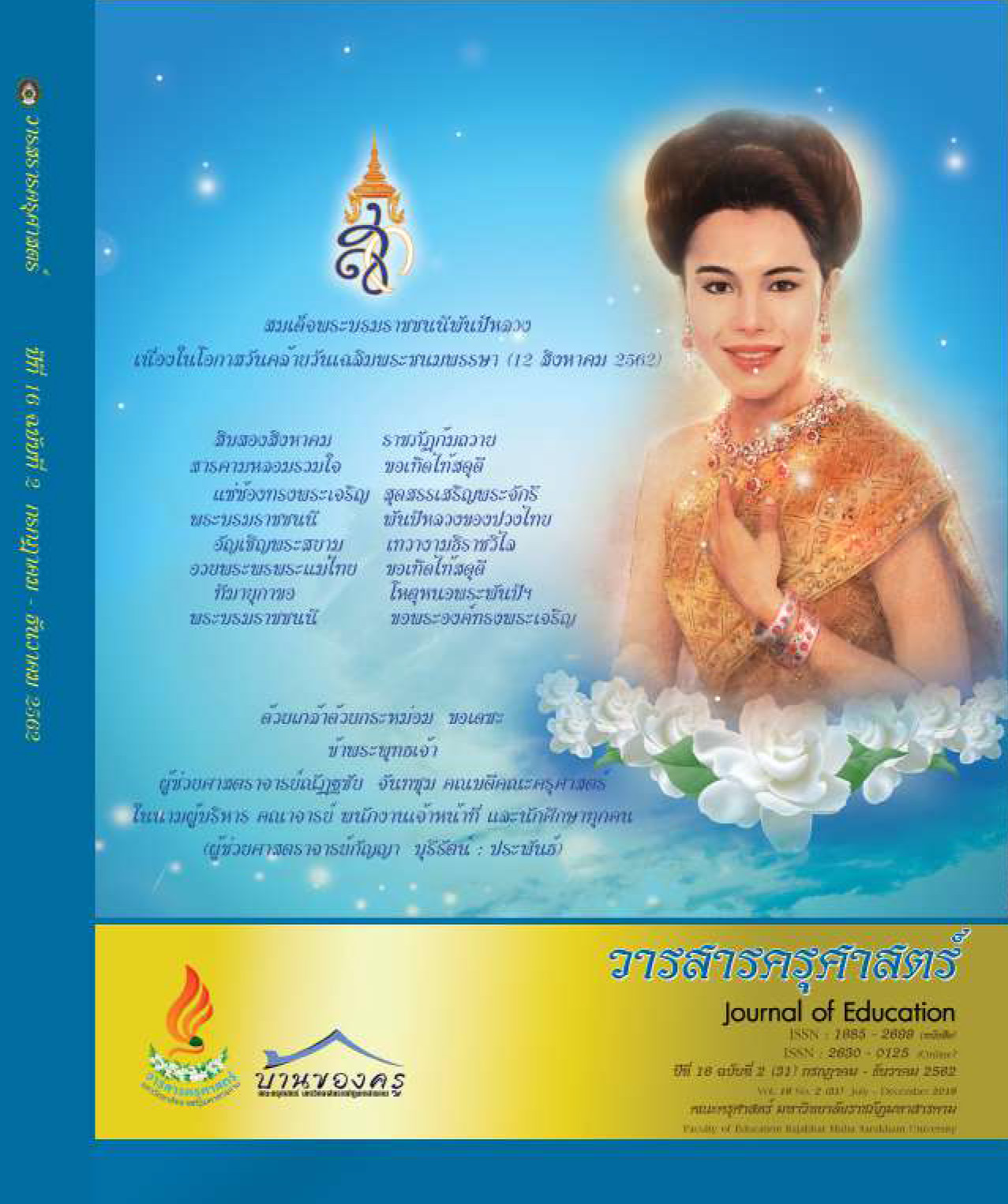The Development of Learning Model to PromoteReading Ability of Student Grade 5
Main Article Content
Abstract
Development of learning model to promote reading ability of student grade 5 (Research and Development. There are research : 1. Synthesize learning management 2. Development learning model. 3. Try to use the learning management. 4. Study the satisfaction of students towards using the learning model to promote. the aroup Were 32 experimental groups and 35 control groups obtained by cluster random sampling with sampling methods Randomize the room level by group random sampling with raffle. The statistics used in the analysis are percentage, mean, standard deviation and t-test.
Result of this reseurch were 1) The synthesis of development of learning model to promote reading Ability of students grade 4-6. The researcher therefore chose to use the CIRC method and the KWL Plus teaching method to develop the learning model to promote reading ability. 2) The development learning model to promote reading Ability of students grade 5 is formed through the evaluation criteria for accuracy and suitability. 3) The results take the form of learning to develop learning model to promote reading abilities of students grade 5 were found. that The average pretest score of the experimental group and the control group the mean score in reading ability is not different. significantly at the level of .05.
4) The results of student satisfaction towards using the learning model to promote reading ability of the students grade 5 showed that were satisfied with using the overall learning model to promote reading ability at a high level (x̄=4.01).
Article Details
ข้อกำหนดเบื้องต้นที่ผู้นิพนธ์(ผู้ส่งบทความ) ควรทราบ
1. ผู้นิพนธ์ที่ประสงค์จะลงตีพิมพ์บทความกับวารสาร ตั้งแต่เดือนมกราคม 2563 เป็นต้นไป ให้ใช้รูปแบบใหม่ (Template 2563) โดยสามารถดูตัวอย่างได้ที่เมนู GUIDELINES
2. จะตีพิมพ์และเผยแพร่ได้ ต้องผ่านการประเมินจากผู้ทรงคุณวุฒิ (Peer Review)
3. การประเมินบทความโดยผู้ทรงคุณวุฒิ (Peer Review) เป็นแบบ Double Blind
4. การอ้างอิงบทความใช้หลักเกณฑ์ APA (American Psychological Association) คลิก
5. บทความถูกปฏิเสธการตีพิมพ์ ไม่ผ่านการประเมิน ผู้นิพนธ์ขอยกเลิกเองหรือชำระเงินก่อนได้รับการอนุมัติ ทางวารสารไม่มีนโยบายการคืนเงิน
References
ฆนัท ธาตุทอง. (2551). การออกแบบการสอนและบูรณาการ. นครปฐม: เพชรเกษมการพิมพ.
ทิศนา แขมมณี. (2557). สำนักงานส่งเสริมสังคมแห่งการเรียนรู้และคุณภาพของเยาวชน. กรุงเทพมหานคร: ไม่ปรากฏสถานที่ที่พิมพ์.
ธีรวุฒิ เอกะกุล. (2552). การวิจัยปฏิบัติการ Action research. อุบลราชธานี: ยงสวัสดิ์อินเตอร์กรุ๊ป.
พรรณทิพย์ ศิริวรรณบุษย์. (2551). ทฤษฎีจิตวิทยาพัฒนาการ. กรุงเทพมหานคร: สำนักพิมพ์แห่งจุฬาลงกรณ์.
มูนาดา หมัดอะด้ำ. (2557). ผลสัมฤทธิ์ทางการเรียนคณิตศาสตร์และความสามารถในการแก้โจทย์ปัญหา การบวก ลบ คูณ กลุ่มสาระเรียนรู้ ภาษาไทย ของนักเรียนชั้นมัธยมศึกษาปีที่ 1 (ปริญญามหาบัณฑิต). มหาวิทยาลัยทักษิณ, สงขลา.
วิโรจน์ สารรัตนะ. (2556). กระบวนทัศน์ใหม่ทางการศึกษา : กรณีนานาทัศนะการศึกษาศตวรรษที่ 21. กรุงเทพมหานคร: ทิพย์วิสุทธิ.
วัชรา เล่าเรียนดี. (2547). เทคนิควิธีการจัดการเรียนรู้สำหรับครูมืออาชีพ. นครปฐม: มหาวิทยาลัยศิลปากร.
แววมยุรา เหมือนนิล. (2556). การอ่านจับใจความ (พิมพ์ครั้งที่ 4). กรุงเทพมหานคร: สุวีริยาสาส์น.
สุวิทย์ มูลคำ และอรทัย มูลคำ. (2545). 21 วิธีจัดการเรียนรู้เพื่อพัฒนาระบบความคิด. กรุงเทพมหานคร: ภาพพิมพ์.
. (2547). การสอนคิดวิเคราะห์. กรุงเทพมหานคร: ภาพพิมพ์.
สํานักงานคณะกรรมการการศึกษาแห่งชาติ. (2545). แนวทางการวัดผลประเมินผลในชั้นเรียนกลุ่มสาระวิทยาศาสตร์ หลักสูตรการศึกษาขั้นพื้นฐาน พุทธศักราช 2544. กรุงเทพมหานคร: องค์การรับส่งสินค้าและพัศดุภัณฑ์ (ร.ส.พ.).
สำนักวิชาการและมาตรฐานการศึกษา. (2555). แนวทางการพัฒนาทักษะชีวิต บูรณาการการเรียนการสอน 8 กลุ่มสาระการเรียนรู้หลักสูตรแกนกลางการศึกษาขั้นพื้นฐาน พุทธศักราช 2551. กรุงเทพมหานคร: ชุมนุมสหกรณ์การเกษตรแห่งประเทศจำกัด.
อาภรณ์พรรณ พงษ์สวัสดิ์. (2550). การพัฒนาความสามารถด้านการอ่านจับใจความ ของนักเรียนชั้นประถมศึกษาปีที่ 5 ที่จัดการเรียนรู้ด้วยเทคนิค KWL Plus (ปริญญาศึกษาศาสตรมหาบัณฑิต สาขาหลักสูตรและการนิเทศ) มหาวิทยาลัยศิลปากร, กรุงเทพมหานคร.
Slavin, R. E. (1995). Cooperative Learning Theory, Research and Practice [2nd ed]. Massachsetts: ASimom & Schuster.

